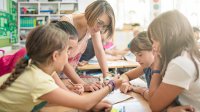Using Rubrics as a Metacognitive Strategy
Teachers in grades K to 2 can use rubrics to guide students to plan, monitor, and evaluate their learning.
Your content has been saved!
Go to My Saved Content.Research from the Education Endowment Foundation finds that if students develop and apply metacognitive strategies, there’s potential for a large positive impact on learning. Planning, monitoring, and evaluating are metacognitive strategies that guide students to think about what they need to do for their learning, check how well they’re doing, and then evaluate the results.
How can teachers harness the learning power of metacognition in younger learners, ages 5 to 7? We can collaborate with students to guide them to develop awareness of metacognition strategies and their impact on learning and apply these strategies throughout their learning careers. Using a rubric, often confined to the assessment part of learning, can support the metacognitive strategy of planning, monitoring, and evaluating.
We can use rubrics before, during, and after a learning experience. When we utilize this common classroom tool more effectively and more extensively, the metacognitive strategy of planning, monitoring, and evaluating will become embedded in the learning process.
In the first example below, we guide young learners to plan for learning. Imagine, for a unit on buildings, that children have been learning about traditional homes from around the world, thinking about why they’re the shape they are and why certain materials were used. To develop design technology skills, they’re tasked with designing and creating a model, selecting from a range of construction materials. The criterion for success of the model (task specific) is that the real-life materials can be identified from the model. The rubric supports skills development—in this instance, being able to explore ways of constructing a design.
To help make the rubric accessible and promote planning for learning, the teacher displays the rubric and poses questions related to skills development at the mastery level. Together the teacher and students can find the answers in the rubric.
Mastery level indicators
I can:
- Try out different tools and materials for making parts of a design
- Keep on trying when I am making parts for a design in different ways
- Think about how well things went with the planning and making of my design
- Talk about how one way of making the design might be better than another
(The above rubric text is reproduced by permission from the International Curriculum Association.)
Teacher questions
To master this skill:
- Will you just try one way of making your model? (No)
- Will you test different materials/media to see which is best? (Yes)
- Will you demonstrate resilience and keep trying when things don’t work out how you want? (Yes)
- Will you talk to other learners to further develop your ideas? (Yes)
The children then share with a partner how they’ll approach designing and making their model. In this way, they’re verbalizing their plan for learning and applying a metacognitive strategy.
The teacher can also guide monitoring by pausing learners partway through the activity and asking the same questions but in the past tense. Here are some examples:
- Have you tried more than one way of making your model?
- Have you tested different materials?
- Have you been resilient even when things didn’t work out?
- Have you talked to other learners to further develop your ideas?
To develop awareness of the metacognitive strategy, ask the children if seeing the rubric and discussing their plans helped them with their learning. This process of reflection promotes knowledge of metacognitive strategies and their impact on learning.
Using rubrics for assessing learning is a common classroom practice; using rubrics for evaluating shifts the focus from assessing the outcome to improving future learning. In the same unit of learning about buildings, children can develop their skills as historians. During a field trip around the local area looking at municipal, industrial, and commercial buildings, children can practice the skill of selecting and recording relevant information about the past.
This may involve taking notes and photographs, recording interviews, or interpreting maps and artifacts. Each child can then apply these skills to share the history of their own home with a peer. Children could record themselves talking about their home and the sources they used and then evaluate using a rubric like the one below—for example, highlighting what they’ve shown they can do. Evaluating will then feed into planning as learners consider what they could do more of or do differently next time they are being a historian.
Mastery level indicators
I can:
- Talk about how one type of historical information is better or worse than another
- List the information that has helped me with my history learning
- Look carefully at an object from the past to help my research
- Compare two sources to find what is the same or different
- Match information to research questions and ignore anything that’s not useful
Developing level indicators
I can:
- Explain why a picture is a helpful type of information or not
- Decide which types of information will help me to find out about an aspect of the past
- Find the answers to questions by carefully looking at the source
- Write down or draw a picture of any helpful information about the past that I have found
Beginning level indicators
I can:
- Decide which pictures will help me to find out about an aspect of the past
- Choose sources that will help me to answer a question
- Find information in a given source to answer a question
(The above rubric text is reproduced by permission from the International Curriculum Association.)
The examples above are just one way to embed metacognition into learning while using rubrics in more diverse ways.
